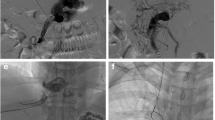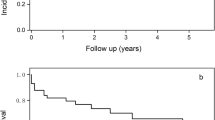Abstract
Purpose
To investigate the efficacy, feasibility, and safety of transjugular intrahepatic portosystemic shunt (TIPS) as a treatment for patients with recurrent portal hypertension with variceal bleeding (RPHVB) who have previously undergone open splenectomy and esophagogastric devascularization (OSED).
Methods
The data were retrospectively retrieved from 39 cirrhotic RPHVB patients who had undergone OSED from August 2015 to December 2020. All patients were treated with TIPS using the Viabahn stent.
Results
Out of the 39 patients included in the study, TIPS was successfully performed in 38 patients with a success rate of 97.44%. One patient had a failed attempt due to cavernous transformation of the portal vein (CTPV). Among the 38 patients who underwent TIPS, 33 patients also underwent varicose vein embolization, while the remaining 5 patients only underwent TIPS procedure. A total of 39 Viabahn stents were implanted, with 5 patients receiving stents expanded to their nominal diameter of 8 mm and the remaining 33 patients having their shunt maintained at a diameter of 6 mm. The postoperative hemostasis rate was 97.37% (37/38). The portal vein pressure (PVP) and portal pressure gradient (PPG) decreased significantly from (31.28 ± 6.24) and (20.61 ± 5.14) mmHg to (19.58 ± 4.69) and (9.24 ± 3.07) mmHg, respectively (P < 0.001). During the follow-up period, the rebleeding rate was 6.09% (2/29), while the incidence of hepatic encephalopathy (HE) and shunt dysfunction was 13.79% (4/29) for each.
Conclusion
Transjugular intrahepatic portosystemic shunt is an effective, feasible and safe treatment for RPHVB patients who have previously undergone OSED. A satisfactory clinical outcome could be achieved with a 6 mm-diameter shunt in most patients.

Similar content being viewed by others
Data availability
All data and materials are available upon reasonable request to the corresponding author.
References
Bosch J, Berzigotti A, Garcia-Pagan JC, Abraldes JG. The management of portal hypertension: rational basis, available treatments and future options. J Hepatol. 2008;48 Suppl 1:S68-S92.
Simonetto DA, Liu M, Kamath PS. Portal Hypertension and Related Complications: Diagnosis and Management. Mayo Clin Proc. 2019;94(4):714-726.
Garcia-Tsao G, Bosch J. Management of varices and variceal hemorrhage in cirrhosis. N Engl J Med. 2010;362(9):823-832.
Feng LS, Chen XP. Combined splenocaval or mesocaval C shunt and portoazygous devascularization in the treatment of portal hypertension: analysis of 150 cases. Hepatobiliary Pancreat Dis Int. 2006;5(1):70-73.
Thomsen BL, Møller S, Sørensen TI. Optimized analysis of recurrent bleeding and death in patients with cirrhosis and esophageal varices. Copenhagen Esophageal Varices Sclerotherapy Project. J Hepatol. 1994;21(3):367–375.
Garcia-Tsao G, Groszmann RJ, Fisher RL, Conn HO, Atterbury CE, Glickman M. Portal pressure, presence of gastroesophageal varices and variceal bleeding. Hepatology. 1985;5(3):419-424.
Tripathi D, Stanley AJ, Hayes PC, et al. Transjugular intrahepatic portosystemic stent-shunt in the management of portal hypertension. Gut. 2020;69(7):1173-1192.
Senzolo M, Tibbals J, Cholongitas E, Triantos CK, Burroughs AK, Patch D. Transjugular intrahepatic portosystemic shunt for portal vein thrombosis with and without cavernous transformation. Aliment Pharmacol Ther. 2006;23(6):767-775.
García-Pagán JC, Saffo S, Mandorfer M, Garcia-Tsao G. Where does TIPS fit in the management of patients with cirrhosis?. JHEP Rep. 2020;2(4):100122.
Saxon RS, Ross PL, Mendel-Hartvig J, Barton RE, Benner K, Flora K, et al. Transjugular intrahepatic portosystemic shunt patency and the importance of stenosis location in the development of recurrent symptoms. Radiology 1998;207:683- 693.
Mamiya Y, Kanazawa H, Kimura Y, et al. Hepatic encephalopathy after transjugular intrahepatic portosystemic shunt. Hepatol Res. 2004;30(3):162-168.
Fanelli F, Salvatori FM, Rabuffi P, et al. Management of refractory hepatic encephalopathy after insertion of TIPS: long-term results of shunt reduction with hourglass-shaped balloon-expandable stent-graft. AJR Am J Roentgenol. 2009;193(6):1696-1702.
Bosch J. Small diameter shunts should lead to safe expansion of the use of TIPS. J Hepatol. 2021;74(1):230-234.
Wang T, Zhou Z, Liang F. Influences of Anatomorphological Features of the Portal Venous System on Postsplenectomy Hemodynamic Characteristics in Patients With Portal Hypertension: A Computational Model-Based Study. Front Physiol. 2021;12:661030.
Huang L, Yu Q, Wang J. Association Between Changes in Splanchnic Hemodynamics and Risk Factors of Portal Venous System Thrombosis After Splenectomy with Periesophagogastric Devascularization. Med Sci Monit. 2018;24:4355-4362.
Sogaard KK, Astrup LB, Vilstrup H, Gronbaek H. Portal vein thrombosis; risk factors, clinical presentation and treatment. BMC Gastroenterol. 2007;7:34.
Ierardi AM, Xhepa G, Piffaretti G, et al. Clinical experience with Angiojet: a comprehensive review. Int Angiol. 2015;34(6 Suppl 1):1-14.
Wolter K, Decker G, Kuetting D, et al. Interventional Treatment of Acute Portal Vein Thrombosis. Interventionelle Therapie der akuten Pfortaderthrombose. Rofo. 2018;190(8):740-746.
Boike JR, Thornburg BG, Asrani SK, et al. North American Practice-Based Recommendations for Transjugular Intrahepatic Portosystemic Shunts in Portal Hypertension. Clin Gastroenterol Hepatol. 2022;20(8):1636-1662.e36.
Fagiuoli S, Bruno R, Debernardi Venon W, et al. Consensus conference on TIPS management: Techniques, indications, contraindications. Dig Liver Dis. 2017;49(2):121-137.
Rössle M. TIPS: 25 years later. J Hepatol. 2013;59(5):1081-1093.
Biecker E. Diagnosis and therapy of ascites in liver cirrhosis. World J Gastroenterol. 2011;17(10):1237-1248.
Colombato L. The role of transjugular intrahepatic portosystemic shunt (TIPS) in the management of portal hypertension. J Clin Gastroenterol. 2007;41 Suppl 3:S344-S351.
Cura M, Cura A, Suri R, El-Merhi F, Lopera J, Kroma G. Causes of TIPS dysfunction. AJR Am J Roentgenol. 2008;191(6):1751-1757.
Wang L, Xiao Z, Yue Z, et al. Efficacy of covered and bare stent in TIPS for cirrhotic portal hypertension: A single-center randomized trial. Sci Rep. 2016;6:21011. Published 2016 Feb 15.
Vilstrup H, Amodio P, Bajaj J, et al. Hepatic encephalopathy in chronic liver disease: 2014 Practice Guideline by the American Association for the Study of Liver Diseases and the European Association for the Study of the Liver. Hepatology. 2014;60(2):715-735.
Jiang MY, Huang H, Lu ML, et al. Application of anficoagulants after transjugular intrahepatic portosystemic shunt. J Clin Hepatol. 2018;34(10):2241-2244. (in Chinese).
Boyer TD, Haskal ZJ; American Association for the Study of Liver Diseases. The role of transjugular intrahepatic portosystemic shunt in the management of portal hypertension. Hepatology. 2005;41(2):386–400.
Schepis F, Vizzutti F, Garcia-Tsao G, et al. Under-dilated TIPS Associate With Efficacy and Reduced Encephalopathy in a Prospective, Non-randomized Study of Patients With Cirrhosis. Clin Gastroenterol Hepatol. 2018;16(7):1153-1162.e7.
Perarnau JM, Le Gouge A, Nicolas C, et al. Covered vs. uncovered stents for transjugular intrahepatic portosystemic shunt: a randomized controlled trial. J Hepatol. 2014;60(5):962–968.
Yao W, Liu JC, Wu YJ, et al. Effect of underdilated transjugular intrahepatic portosystemic shunt on prognosis in patients with prior splenectomy: a propensity score-matched case-control study. Abdom Radiol (NY). 2022;47(10):3615-3627.
Jiang QG, Li JJ, Zheng H, et al. Impact of restrictiVe expansion stent on prognosis of cirrhosis patients with portal hypertension after transjugular intrahepatic portosystemic shunt. Chin J Interv Imaging Ther. 2021; 18(4):193-197. (in Chinese).
Acknowledgements
None.
Funding
None.
Author information
Authors and Affiliations
Contributions
ZW and ZZ contributed equally to this study. ZW and ZZ designed and wrote the manuscript. ZW, ZZ and XG collected and analyzed the data. WX, NW, QZ, MZ and HX critically revised the manuscript.
Corresponding author
Ethics declarations
Competing interests
The authors of this work have nothing to disclose.
Ethical approval
All procedures performed in studies involving human participants were in accordance with the ethical standards of the institutional and/or national research committee and with the 1975 Helsinki declaration and its later amendments or comparable ethical standards. Our study was approved by the Ethics Committee of the Affiliated Hospital of Xuzhou Medical University (Jiangsu, China; XYFY2015-JS020-01). All enrolled patients gave written informed consent. All methods were carried out in accordance with relevant guidelines and regulations.
Additional information
Publisher's Note
Springer Nature remains neutral with regard to jurisdictional claims in published maps and institutional affiliations.
Rights and permissions
Springer Nature or its licensor (e.g. a society or other partner) holds exclusive rights to this article under a publishing agreement with the author(s) or other rightsholder(s); author self-archiving of the accepted manuscript version of this article is solely governed by the terms of such publishing agreement and applicable law.
About this article
Cite this article
Wang, Z., Zhang, Z., Guo, X. et al. Efficacy, feasibility and safety of TIPS in the treatment of recurrent portal hypertension with variceal bleeding after open splenectomy and esophagogastric devascularization. Abdom Radiol (2023). https://doi.org/10.1007/s00261-023-03945-7
Received:
Revised:
Accepted:
Published:
DOI: https://doi.org/10.1007/s00261-023-03945-7




